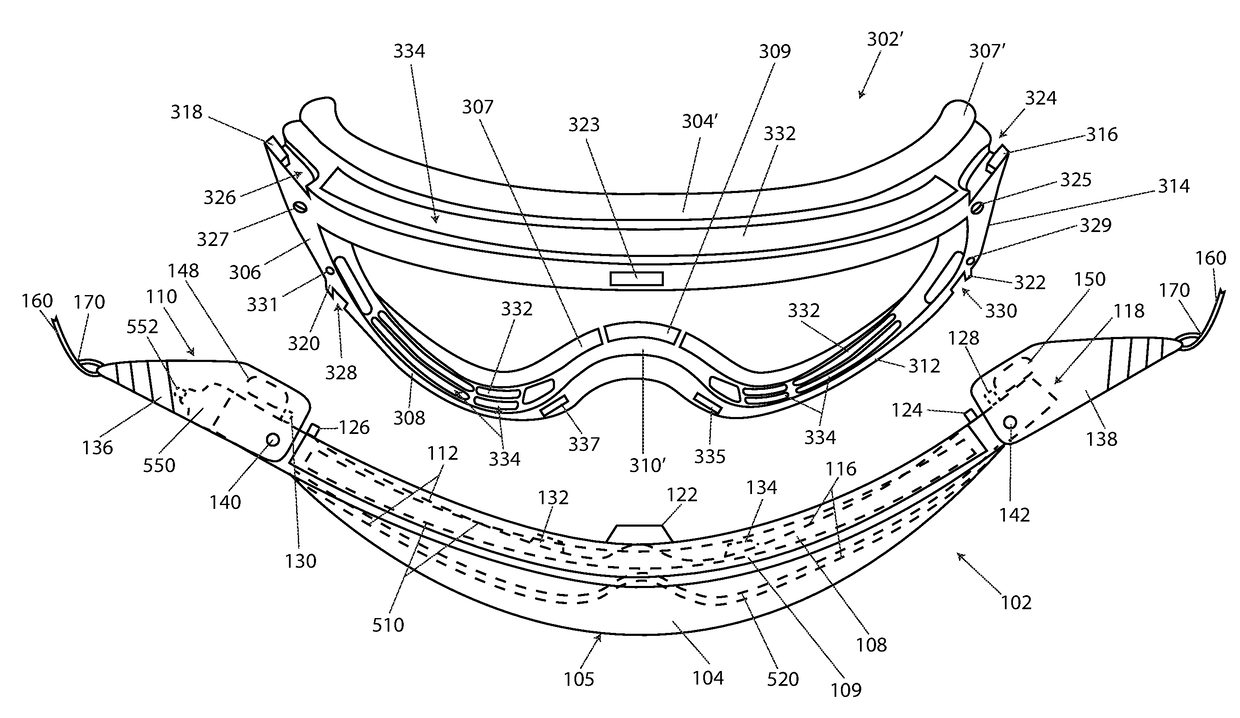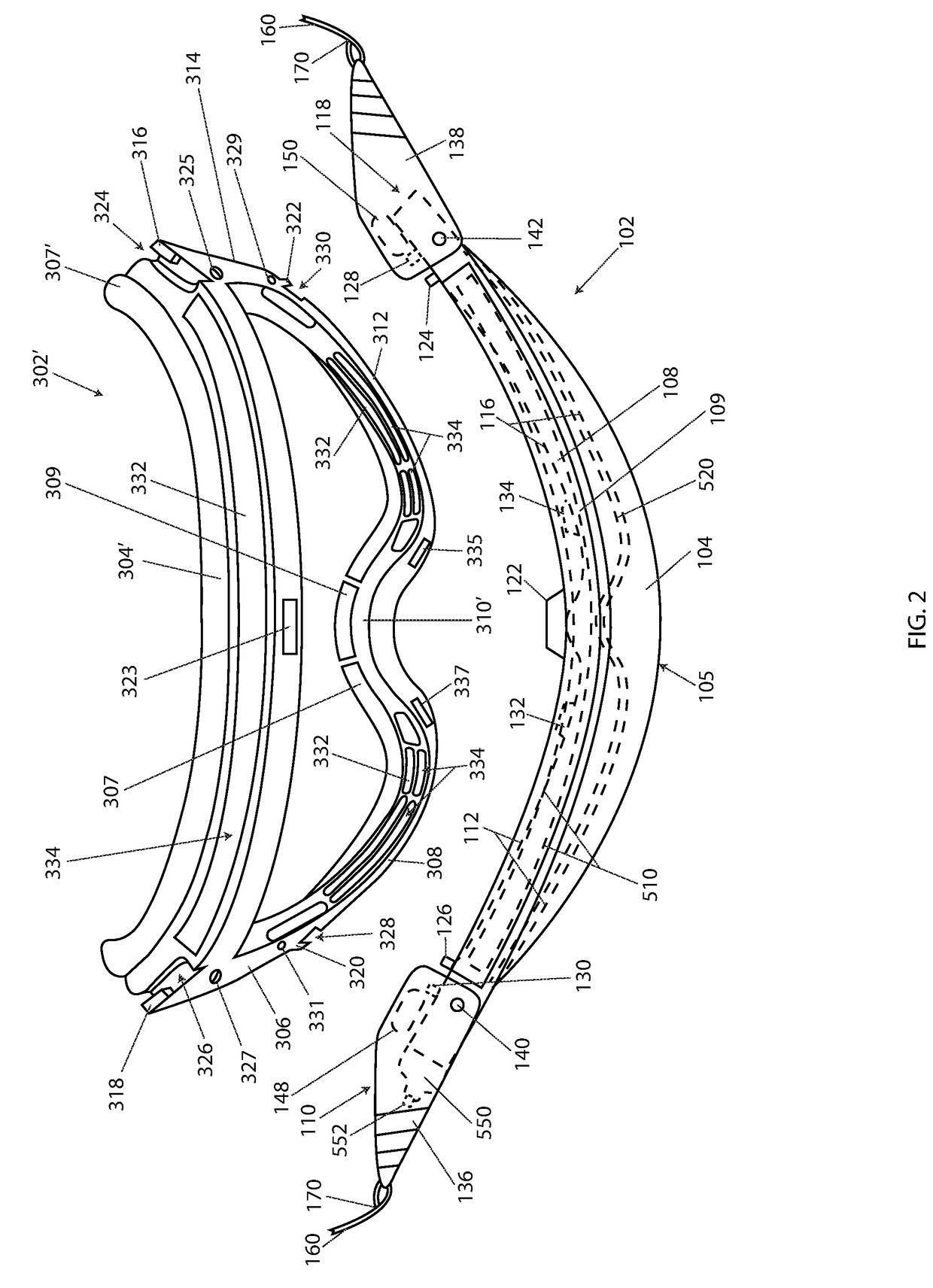The earliest conventional goggles did not provide for interchangeable lenses.
This resulted in a less useful goggle, as changing lighting conditions through the day have rendered the goggle, with just one lens option, less suitable for distinguishing variations in
terrain.
In particular, with snowy
terrain, it is often difficult to determine the presence of
terrain variations because the
snow is all one color: white.
Further, where the lens of the goggle has become damaged, or broken, such goggles have also required replacement of the entire goggle.
Further, prior art goggles have not so much provided for interchangeable goggle frames (i.e., an inexpensive, throw-away, or interchangeable, frame), except insofar as interchanging a lens on a goggle frame necessarily entails a new goggle frame and lens combination (by virtue of the fact that the lens has changed—not the frame).
This has been, at least in part, because there has not been provided in the past a simple interchangeable face gasket for prior art goggles.
This process has been time-consuming and cumbersome, making it difficult for a user to easily interchange lenses, so much so that many have determined to not make an attempt to change the lens in the open, but rather to use a lens that has provided multi-purpose, though not ideal, use for most lighting conditions.
Alternatively, where users have shown the patience necessary to have repeatedly changed lenses, these goggle bodies have lost some resiliency, have broken, or have cracked, due to repeated stressing of the bodies, and this has led to a lack of effective engagement between the lens and the body.
Runckel does not provide for interchangeable face gaskets.
Saylor does not provide for interchangeable face gaskets.
Dondero does not provide for interchangeable face gaskets.
Thus, the strap of Cleary et al., is mounted to the pivotable side arms, however, while the arms of Cleary et al. may at best somewhat reinforce the frame of the goggle, to help better retain the lens in the goggle frame, the arms of that device do not comprise a latch for engaging with the lens directly to hold the Cleary et al. lens on the goggle frame.
The Cleary et al. goggle does not provide for interchangeable face gaskets.
The Scott latch does not interconnect the goggle strap to the goggle body or lens, and the Scott goggle does not provide for interchangeable face gaskets.
However, the Lebel et al. goggle does not provide a latch for facilitating interchangeable and easily releasable engagement between the Lebel et al. goggle body and lens, and Lebel et al. does not provide for interchangeable face gaske
There are many possible conditions which may lead to
fogging of a goggle, since the
dew point of the inside of the lens is affected by varying temperature,
moisture, pressure and ventilation conditions.
One common example of
fogging has occurred when a person who has been skiing,
cycling, hiking or engaging in other strenuous work or combat-related activity, stops moving as quickly as before, thus reducing the amount of air flow over the surfaces of the goggle such that temperature differentials between the inner surface of the goggle and the now warmed and moist air trapped within the goggle, have caused condensation and fogging of the inner surface of the goggle lens.
Another example of a cause of fogging involves a significant increase in physical
exertion and activity which increases the amount of
moisture and heat trapped within the goggle.
In such a case there has existed a greater imbalance in temperature between the inner surface of the goggle lens and the moist warm air trapped within the goggle, causing condensation and fogging on the inner surface of the lens.
Thus, fogging is a common problem with goggles, and this has occurred in various situations involving temperature extremes, when warmer temperatures caused by
perspiration and
respiration have entered within the goggle
enclosure in a warmer state than relatively colder temperature conditions outside of the goggle body.
Of course this problem has ranged from being annoying to the user, to presenting a very dangerous situation where the user's field of vision has been greatly diminished while the user has been traveling at high speeds among fixed obstacles, such as trees, widely varying terrain such as bumps, cliffs, or other participants, or the user has otherwise been unable to clearly see an intended target or an enemy combatant.
The problem of fogged goggles has resulted in injury and even death among goggle users.
None of the foregoing described goggles provides for interchangeable face gaskets.
Despite best efforts to produce a goggle that utilizes passive air-flow means for defogging the lens of the goggle, there are often present conditions which have rendered passive air-flow means of de-fogging ineffective—such as excess
exertion causing corresponding body heating and excess
humidity and temperature conditions within the goggle.
Such conditions have overwhelmed the ability of the passive means to overcome the temperature and
humidity differentials presented by
exertion by a user in cold,
icing conditions or accumulation of
snow clogging ventilation means.
Also, sometimes a user's clothing, especially such as scarves or
face masks, have impeded intended
airflow of such goggles, rendering them ineffective.
While the presence of a dual-pane lens system in a goggle may help prevent some fogging, it has not been entirely adequate to completely prevent fogging, as is evidenced by ongoing and continued efforts attempting to solve the problem of goggle lens fogging with lens coatings, active technologies such as a
fan in a goggle, and heated-lens goggle systems.
But these goggles require additional lens material to manufacture, and thus they are more bulky and more expensive to manufacture.
One problem of such a device is that it does not necessarily overcome
icing,
snow accumulation or other blockage of outer goggle vents, thus rendering such a system less effective.
Also, the Ryden system does not provide for readily-interchangeable face gaskets.
None of the foregoing patents or patent applications provide for readily-interchangeable face gaskets.
A downside of such a system is that the wires are visible, may obstruct vision, and may lead to uneven heating of the
entire lens.
This inefficiency, in turn, has resulted in wasted energy and corresponding less battery
longevity for the system.
Of course, the chrome of both the
heating element and the
bus bars is visible, and this may be undesirable.
Further, neither Curcio nor McCooeye provides for readily-interchangeable face gaskets.
Access by
moisture to electronic components may cause short circuits, it may permanently damage the electronic components, it may corrode electrical components, and it may lead to temporary or total failure of the components and device as well.
In particular, a heretofore unknown problem arises with prevention of water and moisture from entering into goggle electronic components that are adapted for easy interchange of heated lenses, since part of the
electronic circuit for such a goggle typically resides on a removable lens, and the other part of the circuit has resided in the goggle body.
Thus, interconnecting the two parts, the lens and the body, and detaching the same, in a manner as simply as possible in as few simple steps as possible, has proven challenging to resolve while also providing an installed
interconnection that doesn't
risk exposure of
electronics components of the goggle to moisture and
water damage during use of the goggle.
Further, Sperbeck does not provide a less-costly-to-manufacture engaging system, wherein a specific heating pattern may be applied to the eye-shield to prevent hot spots or to otherwise provide customized heating.
 Login to View More
Login to View More  Login to View More
Login to View More 


